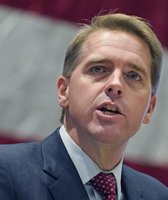Stand up for the facts!
Our only agenda is to publish the truth so you can be an informed participant in democracy.
We need your help.
I would like to contribute
In state after state, Democrats are using health care like a cudgel against Republicans.
In a West Virginia ad, Democratic Senate incumbent Joe Manchin takes a rifle and literally blows a hole in a Republican lawsuit that aims to wipe out the Affordable Care Act. Another incumbent, Sen. Claire McCaskill, D-Mo., charged her Republican opponent with seeking to eliminate current health care protections.
For his part, President Donald Trump fires up the Republican base with the inaccurate allegation that Democrats "want to raid Medicare to pay for their socialist agenda."
In the fray, hard numbers are easily lost. So here’s a set of key health care facts to remember as those TV ads blur the truth.
Who’s at risk with pre-existing conditions?
Before the Affordable Care Act, insurance companies could freely exclude coverage for health issues that predated the day a person’s policy kicked in. Except for grandfathered plans, the Affordable Care Act ended that. It has proven to be one of the most popular parts of the law, winning high marks from voters across the political spectrum.
Sign up for PolitiFact texts
The Trump administration decided not to defend the law in a lawsuit in Texas, supported by 20 state attorneys general.
How many people could be at risk of the law is overturned and nothing replaces it? A 2017 report from the Obama administration had a low-end estimate of about 60 million out of about 263 million non-elderly people. The Kaiser Family Foundation put the figure at 52 million. Cynthia Cox, a top policy analyst at Kaiser, told us that is a conservative estimate of who might be vulnerable.
"We’re focusing on people who would have been denied coverage, but many more would have been able to get coverage but charged more based on their medical history," Cox told PolitiFact.
Tracking how many people have insurance
The Trump administration took several steps to trim the reach of the Affordable Care Act, from tightening the sign-up period to rescinding reimbursements to insurance companies, a move that led to higher premiums. A central question is whether the fraction of uninsured grew.
The answer remains unclear. The gold standard survey from the government, the National Health Interview Survey, found no statistically significant shift between the average for all of 2017 and the first quarter of 2018.
But other polling, including a large effort by the Urban Institute, has found small but statistically significant signs that progress has stalled and might be reversing. Looking at first quarter findings since 2013, both the government and Urban Institute figures show a small increase.
The Urban Institute spotted larger increases in states that didn’t expand Medicaid, such as Texas and Florida.
"It’s likely that national averages mask what’s happening in different states based on their decisions about expanding Medicaid under the Affordable Care Act," said Stephen Zuckerman, co-director of the institute’s Health Policy Center.
Employer coverage dominates the insurance market
One of the most common misunderstandings about health insurance is who is touched by the big policy debate over Obamacare. Republicans decried the double-digit premium hikes in plans sold through the Affordable Care Act exchanges, or marketplaces. Lost in the rhetoric was the small fraction of Americans this involves.
Those plans are in the individual or generally non-group part of the market. About 16 million people fall into that category. Employer-based plans cover about 158 million people. Their premiums have gone up gradually.
One important wrinkle in the Obamacare debate is the split between those who get premium subsidies and those who don’t. The first group, about 8 million people, are sheltered against premium hikes because when the price goes up, so do the subsidies. But the second group, also about 8 million people, are fully exposed to price increases.
An increasing burden on workers
Most families get insurance through an employer, and the great majority of them pay a share of their monthly premiums. One of the more challenging trends for families is their share has gone up faster than the rise in premiums.
In other words, the burden on families has increased over time.
To make matters worse, premiums have gone up faster than wages.
This is just a partial measure of the rising burden on workers. Deductibles, the part a person pays before the health plan kicks in, have also gone up. Looking at deductibles, co-insurance and co-pays between 2008 and 2016, total out-of-pocket expenses went up over 50 percent, according to an analysis by the Peterson Center on Health Care and the Kaiser Family Foundation.
The tough nut of rising prices
At the bottom of the country’s struggle over health care is that prices steadily rise faster than inflation. Hospitals, doctors, drug companies and other suppliers continue to charge more.
Why? It is not because Americans are getting older, sicker or using more services.
"It’s because we’re being charged more for stuff," said Peterson Center on Health Care executive director Jay Want.
When rising prices meet an aging population, the result is predictable. An ever increasing share of the economy goes toward health care.
The latest government tally found spending reached $3.3 trillion in 2016, a 4.3 percent increase from the year before. As a fraction of gross domestic product, the Centers for Medicare and Medicaid Services predicts health care will go from 17.9 percent in 2016 to 19.7 percent by 2026.
A sampler of claims about health care, fact-checked
Health care has been one of the most frequent topics we’ve rated on the Truth-O-Meter. You can see them all here. A scan of the more recent examples shows how the battle is playing out at the state level.
Maine’s Democratic Party said Republican Rep. Bruce Poliquin "voted to strip 117,000 Mainers of their insurance." This was based on Poliquin’s votes to repeal Obamacare and replace it with the American Health Care Act. That’s a high-end estimate of people who would lose access to insurance under the proposed changes, so we rated it Half True.
In the Ohio governor’s race, Democrat Richard Cordray said Republican Mike DeWine wanted to allow insurance companies to refuse to pay for pre-existing conditions." Cordray based that on DeWine’s votes and legal suits against Obamacare. DeWine’s track record includes efforts to help people with pre-existing conditions, so we rated this Half True.
A Democratic candidate for state Senate in North Carolina said "health care premiums in North Carolina are now among the five highest states in the country." That’s only accurate for policies in the individual market. And as we show above, that’s a small fraction of the insurance market. Overall, employer-based premiums in North Carolina fall in the middle of the pack. We rated this Mostly False.
In Michigan, Republican Rep. Mike Bishop accused Democratic challenger Elissa Slotkin of backing a plan to take Medicare away from current senior recipients. Bishop was thinking of the Medicare for All proposal backed by many Democrats. The claim is sketchy in the first place, but Slotkin hasn’t thrown in with Medicare for All. Instead, she’s suggested an optional buy-in for people under 65. We rated this claim False.
Our Sources
Centers for Disease Control and Prevention, Health Insurance Coverage: Early Release of Estimates From the National Health Interview Survey, January–March 2018, August 2018
Georgetown Center on Health Insurance Reforms, ACA Consumer Protections for Private Coverage, accessed Oct. 8, 2018
Health Affairs, Adults’ Uninsurance Rates Increased By 2018, Sept. 26, 2018
Centers for Disease Control and Prevention, Quarterly NHIS estimates, August 2018
U.S. Health and Human Services, Health insurance coverage for Americans with pre existing conditions, Jan. 5, 2017
Kaiser Family Foundation, Pre-existing Conditions and Medical Underwriting in the Individual Insurance Market Prior to the ACA, Dec. 12, 2016
Kaiser Family Foundation, 2018 Employer Health Benefits Survey, Oct. 3, 2018
Centers for Medicare and Medicaid Services, National Health Expenditure Data, Aug. 1, 2018
Peterson Center on Healthcare, Price and intensity identified as the major drivers of rising healthcare spending, Nov. 8, 2017
Congressional Budget Office, Federal Subsidies for Health Insurance Coverage for People Under Age 65: 2018 to 2028, May 2018
Medicare Trustees, 2018 report, June 5, 2018
Interview, Stephen Zuckerman and Michael Karpman, Health Policy Center, Urban Institute, Oct. 5, 2018
Email interview, Cynthia Cox, associate director, Study of Health Reform and Private Insurance, Kaiser Family Foundation, Oct. 8, 2018






















































